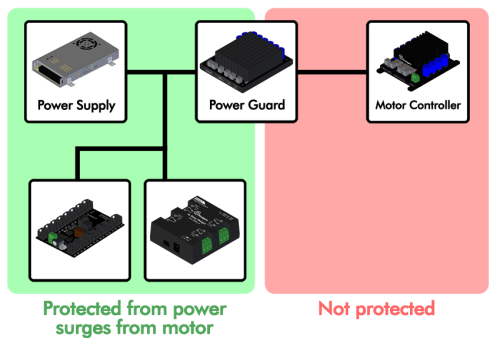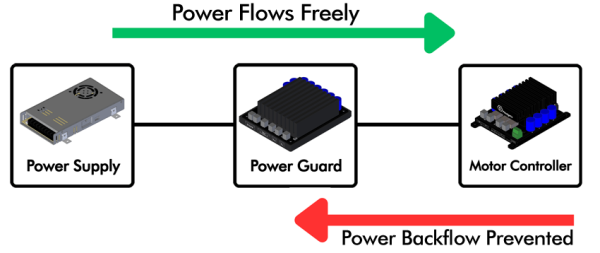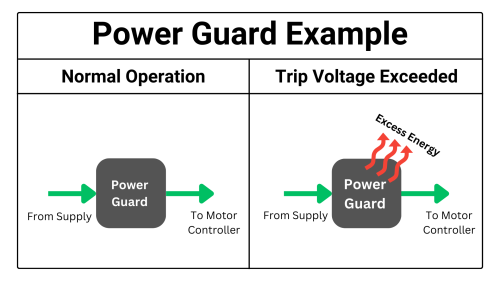Power Guard Guide: Difference between revisions
(Created page with "{{#seo: |description=What is a Power Guard Phidget? }} Category:IntroGuide __TOC__ ==Introduction== In this guide, we will provide an overview of power guards and discuss how they can be used in motor applications to protect your system and improve reliability. ==What Is a Power Guard?== A power guard protects your power supply and other devices in your system from power surges caused by motors. center|600px As shown in the i...") |
No edit summary |
||
| Line 22: | Line 22: | ||
==How Does a Power Guard Work?== | ==How Does a Power Guard Work?== | ||
[[Image:Power_guard_example.png|thumb|500px|link=https:// | [[Image:Power_guard_example.png|thumb|500px|link=https://cdn.phidgets.com/docs/images/e/e7/Power_guard_example.png]] | ||
A power guard can be thought of as a one-way valve for electricity. A power supply is connected to the input of the power guard, and the output is connected to a motor controller. | A power guard can be thought of as a one-way valve for electricity. A power supply is connected to the input of the power guard, and the output is connected to a motor controller. | ||
Revision as of 22:00, 18 November 2024
Introduction
In this guide, we will provide an overview of power guards and discuss how they can be used in motor applications to protect your system and improve reliability.
What Is a Power Guard?
A power guard protects your power supply and other devices in your system from power surges caused by motors.
As shown in the image above, a power guard allows power to flow freely from the power supply to the motor controller, but it prevents any power from flowing in the reverse direction.
What Is a Power Guard Necessary?
For applications involving motors, it is very likely that energy will be regenerated from the motor, creating voltage surges. These surges can cause instability in your system and, in many cases, can cause irreparable damage to your power supply, motor controller, and other devices in your application.
Voltage Surge Example
The video below shows how a voltage surge can damage your system.
How Does a Power Guard Work?
A power guard can be thought of as a one-way valve for electricity. A power supply is connected to the input of the power guard, and the output is connected to a motor controller.
If the voltage on the output of the power guard increases beyond a predetermined safe limit (i.e. the Trip Voltage has been exceeded), the power guard will immediately attempt to regulate the voltage. It does this by converting the extra energy into heat.
Some power guards designed by Phidgets Inc. have advanced sensing and capabilities, however, all power guards generally function in the manner described above.
Does My Application Require a Power Guard?
To determine if your application requires a power guard, consider your power supply, the rated current of your motor, regenerative charging requirements, and the Phidget motor controller you are using.
Power Guard FAQ
Can I Use Multiple Power Guard Phidgets in Parallel
No. We do not recommend using Power Guard Phidgets in parallel.
Can I Use One Power Guard Phidget with Multiple Motor Controllers?
Yes, as long as the worst-case regenerated current is not higher than the continuous current rating of your Power Guard Phidget.
How Should I Connect Other Devices To My System?
If your system includes a power guard, it is important to connect all other devices upstream of the power guard. This will ensure that they are protected from any power surges.



